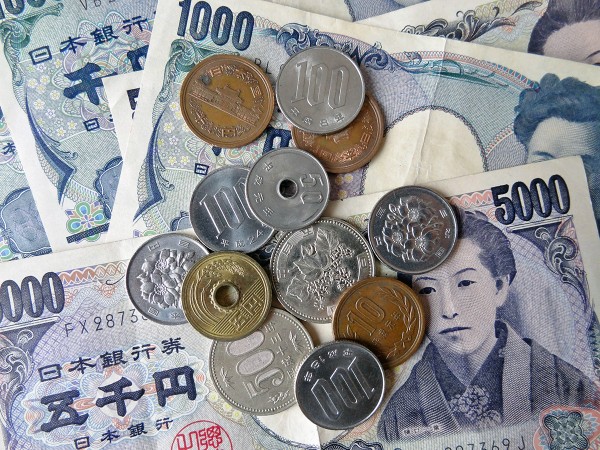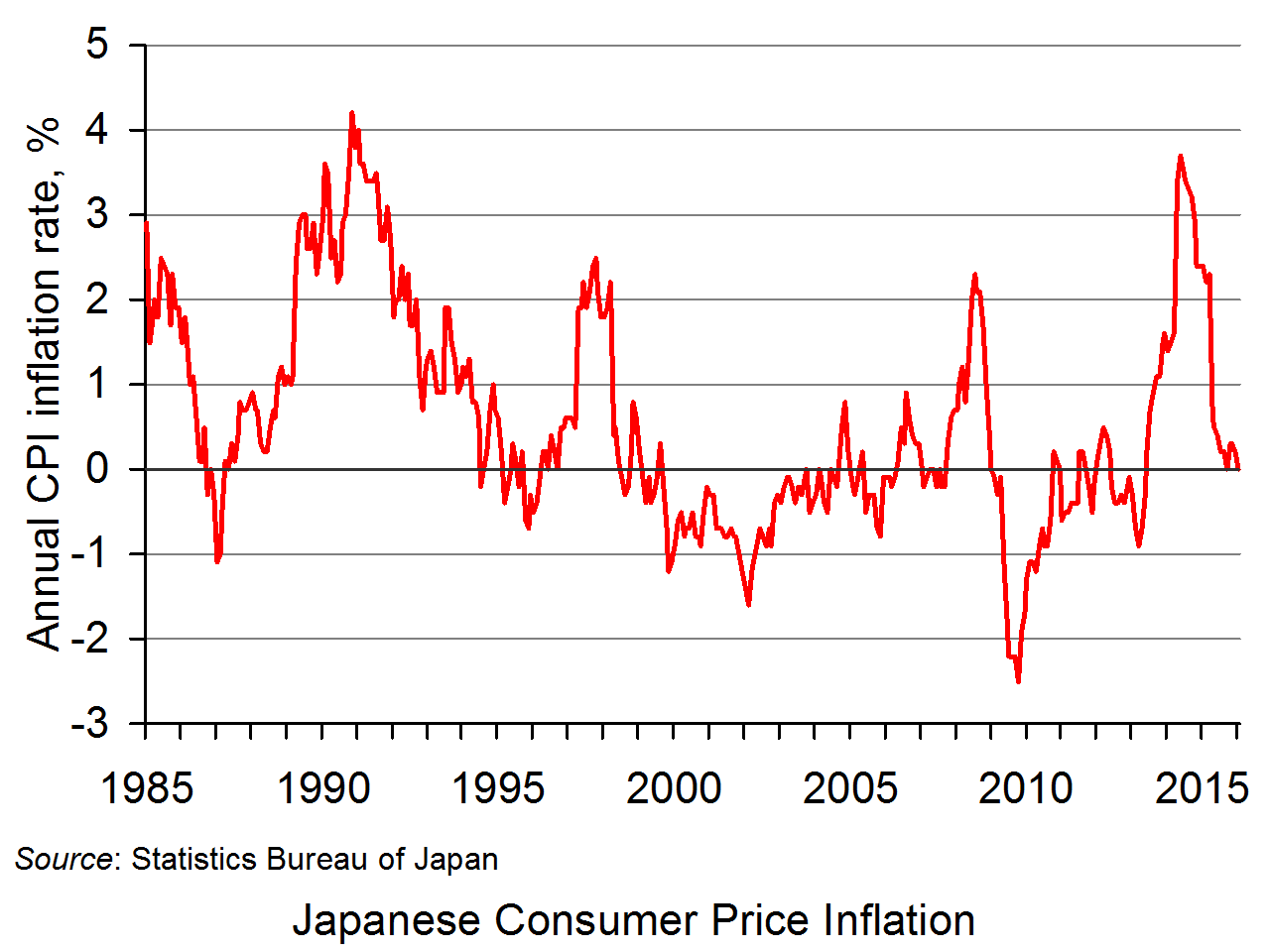 In the blog Japan’s interesting monetary policy as deflation fears grow we detailed the aggressive monetary measures of Japan’s central bank to prevent a deflationary mindset becoming again established. In January it introduced a negative interest rate on some deposits placed with it by commercial banks. This is in addition to it massive quantitative easing programme to boost the country’s money supply. Despite this, the latest consumer price inflation data show inflation now running at zero per cent.
In the blog Japan’s interesting monetary policy as deflation fears grow we detailed the aggressive monetary measures of Japan’s central bank to prevent a deflationary mindset becoming again established. In January it introduced a negative interest rate on some deposits placed with it by commercial banks. This is in addition to it massive quantitative easing programme to boost the country’s money supply. Despite this, the latest consumer price inflation data show inflation now running at zero per cent.
 As the chart shows, since the mid 1990s there have been protracted periods of Japanese price deflation (click here to download a PowerPoint file of the chart). In January 2013 Japan introduced a 2 per cent CPI inflation target. This was accompanied by a massive expansion of its quantitative easing programme, through purchases of government bonds from investors.
As the chart shows, since the mid 1990s there have been protracted periods of Japanese price deflation (click here to download a PowerPoint file of the chart). In January 2013 Japan introduced a 2 per cent CPI inflation target. This was accompanied by a massive expansion of its quantitative easing programme, through purchases of government bonds from investors.
Following this substantial monetary loosening, buoyed too by a loosening of fiscal policy, the rate of inflation rose. It reached 3.7 per cent in May 2014.
However, through 2015 the rate of inflation began to fall sharply, partly the result of falling commodity prices, especially oil. The latest inflation data show that the annual rate of CPI inflation in January 2016 fell to zero percent. In other words, consumer prices were on average at the levels seen in January 2015.
 The latest inflation numbers appear give further credence to the fear of the Bank of Japan that deflation is set to return. The introduction of a negative deposit rate was the latest move to prevent deflation. As well as encouraging banks to lend, the move is intended to affect expectations of inflation. By adopting such an aggressive monetary stance the central bank is looking to prevent a deflationary mindset becoming re-established. Hence, by increasing the expectations of the inflation rate and by raising wage demands the inflation rate will rise.
The latest inflation numbers appear give further credence to the fear of the Bank of Japan that deflation is set to return. The introduction of a negative deposit rate was the latest move to prevent deflation. As well as encouraging banks to lend, the move is intended to affect expectations of inflation. By adopting such an aggressive monetary stance the central bank is looking to prevent a deflationary mindset becoming re-established. Hence, by increasing the expectations of the inflation rate and by raising wage demands the inflation rate will rise.
The loosening of monetary policy through a negative interest rate follows the acceleration of the quantitative easing programme announced in October 2015 to conduct Open Market Operations so as to increase the monetary base annually by ¥80 trillion.
of the quantitative easing programme announced in October 2015 to conduct Open Market Operations so as to increase the monetary base annually by ¥80 trillion.
The decline of Japan’s inflation rate to zero may yet mean that further monetary loosening might be called for. Eradicating a deflationary mindset is proving incredibly difficult. Where next for Japan’s monetary authorities?
Data
Consumer Price Index Statistics Bureau of Japan
New Articles
Japan’s inflation drops to zero in January MarketWatch, Takashi Nakamichi (25/2/16)
Japan inflation falls back to zero in January: govt AFP (26/2/16)
With pause in inflation, many brace for retreat Nikkei Asian Review (27/2/16)
Japan’s inflation rate has fallen again – to 0% Business Insider Australia, David Scutt (26/2/16)
Previous Articles
Bank of Japan adopts negative interest rate policy CNBC, Nyshka Chandran (29/1/16)
Japan adopts negative interest rate in surprise move BBC News (29/1/16)
Bank of Japan shocks markets by adopting negative interest rates The Guardian, Justin McCurry (29/1/16)
Japan stuns markets by slashing interests rates into negative territory The Telegraph, Mehreen Khan (29/1/16)
Japan introduces negative interest rate to boost economy The Herald, (29/1/16)
Questions
- What is deflation?
- What are the dangers of deflation? Why is the Bank of Japan keen to avoid expectations of deflation becoming re-established?
- To what extent are national policy-makers able to exert pressure over the rate of inflation?
- What does a negative interest rate on deposits mean for depositors?
- What effect is the Bank of Japan hoping that a negative deposit rate will have on the Japanese economy? How would such effects be expected to occur?
- What effect might the Bank of Japan’s actions be expected to have on the structure of interest rates in the economy?
- How might the negative interest rate effect how people wish to hold their wealth?
 The perceived wisdom is that nominal interest rates have a lower zero bound. The Swedish central bank (the Ricksbank) has effectively been charging financial institutions to deposit money at the central bank since 2009. On 29 January 2016 the Central Bank of Japan also introduced a negative interest rate on deposits. The -0.1 per cent rate currently applies to a portion of the reserves held by financial institutions at the central bank. The move is another attempt to pump energy into a struggling economy.
The perceived wisdom is that nominal interest rates have a lower zero bound. The Swedish central bank (the Ricksbank) has effectively been charging financial institutions to deposit money at the central bank since 2009. On 29 January 2016 the Central Bank of Japan also introduced a negative interest rate on deposits. The -0.1 per cent rate currently applies to a portion of the reserves held by financial institutions at the central bank. The move is another attempt to pump energy into a struggling economy.
 As the chart shows, since the mid 1990s there have been protracted periods of Japanese price deflation. In January 2013 Japan introduced a 2 per cent CPI inflation target. This was accompanied by a massive expansion of its quantitative easing programme, principally through purchases of government bonds from investors. Following the monetary loosening, buoyed too by a loosening of fiscal policy, the rate of inflation rose. It reached 3.7 per cent in May 2014.
As the chart shows, since the mid 1990s there have been protracted periods of Japanese price deflation. In January 2013 Japan introduced a 2 per cent CPI inflation target. This was accompanied by a massive expansion of its quantitative easing programme, principally through purchases of government bonds from investors. Following the monetary loosening, buoyed too by a loosening of fiscal policy, the rate of inflation rose. It reached 3.7 per cent in May 2014.
However, through 2015 the rate of inflation began to fall sharply, partly the result of falling commodity prices, especially oil. Now there appears to be an increasing fear at the Bank of Japan that deflation may be set to return. The introduction of a negative deposit rate is intended to prevent deflation. In particular by affecting expectations of inflation. The hope is to prevent a deflationary mindset becoming re-established.
 The further loosening of monetary policy through a negative interest rate follows on the heels of an acceleration of quantitative easing last October. Back then, the Bank of Japan said that it would conduct Open Market Operations so that the monetary base would increase annually be ¥80 trillion. This was reaffirmed in its 29 January announcement. For an economy that has experienced four recessionary contractions since 2008 and with provisional estimates suggesting that it contracted by 0.4 per cent in the final quarter of 2015, it remains to be seen whether further monetary loosening might yet be called for.
The further loosening of monetary policy through a negative interest rate follows on the heels of an acceleration of quantitative easing last October. Back then, the Bank of Japan said that it would conduct Open Market Operations so that the monetary base would increase annually be ¥80 trillion. This was reaffirmed in its 29 January announcement. For an economy that has experienced four recessionary contractions since 2008 and with provisional estimates suggesting that it contracted by 0.4 per cent in the final quarter of 2015, it remains to be seen whether further monetary loosening might yet be called for.
Data
Consumer Price Index Statistics Bureau of Japan
Articles
Bank of Japan adopts negative interest rate policy CNBC, Nyshka Chandran (29/1/16)
Japan adopts negative interest rate in surprise move BBC News (29/1/16)
Bank of Japan shocks markets by adopting negative interest rates Guardian, Justin McCurry (29/1/16)
Japan stuns markets by slashing interests rates into negative territory Telegraph, Mehreen Khan (29/1/16)
Japan introduces negative interest rate to boost economy The Herald, (29/1/16)
Questions
- What does a negative interest rate on deposits mean for depositors?
- What effect is the Bank of Japan hoping that a negative deposit rate will have on the Japanese economy? How would such effects be expected to occur?
- What effect might the Bank of Japan’s actions be expected to have on the structure of interest rates in the economy?
- How might the negative interest rate effect how people wish to hold their wealth?
- What are the dangers of deflation? Why is the Bank of Japan keen to avoid expectations of deflation becoming re-established?
- To what extent are national policy-makers able to exert pressure over the rate of inflation?
 The mood has changed in international markets. Investors are becoming more pessimistic about recovery in the world economy and of the likely direction of share prices. Concern has centred on the Chinese economy. Forecasts are for slower Chinese growth (but still around 5 to 7 per cent) and worries centre on the impact of this on the demand for other countries’ exports.
The mood has changed in international markets. Investors are becoming more pessimistic about recovery in the world economy and of the likely direction of share prices. Concern has centred on the Chinese economy. Forecasts are for slower Chinese growth (but still around 5 to 7 per cent) and worries centre on the impact of this on the demand for other countries’ exports.
The Chinese stock market has been undergoing turmoil over the past few weeks, and this has added to jitters on other stock markets around the world. Between the 5th and 24th of August, the FTSE 100 fell by 12.6%, from 6752 to 5898; the German DAX fell by 17.1% from 11,636 to 9648 and the US DOW Jones by 10.7% from 17,546 to 15,666. Although markets have recovered somewhat since, they are very volatile and well below their peaks earlier this year.
But are investors right to be worried? Will a ‘contagion’ spread from China to the rest of the world, and especially to its major suppliers of raw materials, such as Australia, and manufactured exports, such as the USA and Germany? Will other south-east Asian countries continue to slow? Will worries lead to continued falls in stock markets as pessimism becomes more entrenched? Will this then impact on the real economy and lead then to even further falls in share prices and further falls in aggregate demand?

Or will the mood of pessimism evaporate as the Chinese economy continues to grow, albeit at a slightly slower rate? Indeed, will the Chinese authorities introduce further stimulus measures (see the News items What a devalued yuan means to the rest of the world and The Shanghai Stock Exchange: a burst bubble?), such as significant quantitative easing (QE)? Has the current slowing in China been caused, at least in part, by a lack of expansion of the monetary base – an issue that the Chinese central bank may well address?
Will other central banks, such as the Fed and the Bank of England, delay interest rate rises? Will the huge QE programme by the ECB, which is scheduled to continue at €60 billion until at least September 2016, give a significant boost to recovery in Europe and beyond?
The following articles explore these questions.
Articles
The Guardian view on China’s meltdown: the end of a flawed globalisation The Guardian, Editorial (1/9/15)
Central banks can do nothing more to insulate us from the Asian winter The Guardian, Business leader (6/9/15)
Where are Asia’s economies heading BBC News, Karishma Vaswani (4/9/15)
How China’s cash injections add up to quantitative squeezing The Economist (7/9/14)
Nouriel Roubini dismisses China scare as false alarm, stuns with optimism The Telegraph, Ambrose Evans-Pritchard (4/9/15)
 Markets Are Too Pessimistic About Chinese Growth Bloomberg, Nouriel Roubini (4/9/15)
Markets Are Too Pessimistic About Chinese Growth Bloomberg, Nouriel Roubini (4/9/15)
Data
World Economic Outlook databases IMF: see, for example, data on China, including GDP growth forecasts.
Market Data Yahoo: see, for example, FTSE 100 data.
Questions
- How do open-market operations work? Why may QE be described as an extreme form of open-market operations?
- Examine whether or not the Chinese authorities have been engaging in monetary expansion or monetary tightening.
- Is an expansion of the monetary base necessary for there to be a growth in broad money?
- Why might the process of globalisation over the past 20 or so years be described a ‘flawed’?
- Why have Chinese stock markets been so volatile in recent weeks? How seriously should investors elsewhere take the large falls in share prices on the Chinese markets?
- Would it be fair to describe the Chinese economy as ‘unstable, unbalanced, uncoordinated and unsustainable’?
- What is the outlook over the next couple of years for Asian economies? Explain.
- For what reasons might stock markets have overshot in a downward direction?
 The spectre of deflation haunts the eurozone economy. Inflation in the 12 months to May 2014 was 0.5%, down from 0.7% to April and well below the target of 2% (see). Price deflation can result in deflation of the whole economy. With the prospect of falling prices, many consumers put off spending, hoping to buy things later at a lower price. This delay in spending deflates aggregate demand and can result in a decline in growth or even negative growth: hardly a welcome prospect as the eurozone still struggles to recover from the long period of recession or sluggish growth that followed the 2007–8 financial crisis.
The spectre of deflation haunts the eurozone economy. Inflation in the 12 months to May 2014 was 0.5%, down from 0.7% to April and well below the target of 2% (see). Price deflation can result in deflation of the whole economy. With the prospect of falling prices, many consumers put off spending, hoping to buy things later at a lower price. This delay in spending deflates aggregate demand and can result in a decline in growth or even negative growth: hardly a welcome prospect as the eurozone still struggles to recover from the long period of recession or sluggish growth that followed the 2007–8 financial crisis.
The ECB is well aware of the problem. Its President, Mario Draghi, has stated on several occasions that the central bank will do whatever it takes to ward off deflation and stimulate recovery. At its monthly meeting on 5 June, the ECB Council acted. It took the following measures (see Mario Draghi’s press conference and the press release):
• The main refinancing rate it charges banks on reverse repos (when using open-market operations) was cut from 0.25% to 0.15%.
• The rate it pays banks for depositing money in the ECB was cut from 0% to –0.1%. In other words, banks would be charged for ‘parking’ money with the ECB rather than lending it.
• It will provide targeted lending to banks (targeted longer-term refinancing operations (TLTROs)), initially of 7% of the total amount of each banks’ loans to the non-financial private sector within the eurozone. This will be provided in two equal amounts, in September and December 2014. These extra loans will be for bank lending to businesses and households (other than for house purchase). The total amount will be some €400 billion. Substantial additional lending will be made available quarterly from March 2016 to June 2016.
• It will make preparations for an asset purchase scheme. Unlike that in the UK, which involves the purchase of government bonds, this will involve the purchase of assets which involve claims on private-sector (non-financial) institutions. Depending on financing arrangements, this could amount to quantitative easing.
 • It will suspend sterilising the extra liquidity that has been injected under the Securities Markets Programme (operated from May 2010 to September 2012), which involved purchasing eurozone countries’ existing bonds on the secondary market. In other words it will stop preventing the securities that have been purchased from increasing money supply. This therefore, for the first time, represents a genuine form of quantitative easing.
• It will suspend sterilising the extra liquidity that has been injected under the Securities Markets Programme (operated from May 2010 to September 2012), which involved purchasing eurozone countries’ existing bonds on the secondary market. In other words it will stop preventing the securities that have been purchased from increasing money supply. This therefore, for the first time, represents a genuine form of quantitative easing.
The question is whether the measures will be enough to stimulate the eurozone economy, prevent deflation and bring inflation back to around 2%. The measures are potentially significant, especially the prospect of quantitative easing – a policy pursued by other main central banks, such as the Fed, the Bank of England and the Bank of Japan. A lot depends on what the ECB does over the coming months.
The following articles consider the ECB’s policy. The first ones were published before the announcement and look at alternatives open to the ECB. The others look at the actual decisions and assess how successful they are likely to be.
Articles published before the announcement
Mario Draghi faces moment of truth as man with power to steady eurozone The Observer, Larry Elliott (1/6/14)
What the ECB will do in June? Draghi spells it out The Economist (26/5/14)
Draghi as Committed as a Central Banker Gets, as Economists Await ECB Stimulus Bloomberg, Alessandro Speciale and Andre Tartar (19/5/14)
ECB’s credit and credibility test BBC News, Robert Peston (2/6/14)
90 ECB decamps to debate monetary fixes Financial Times, Claire Jones (25/5/14)
Speech
Monetary policy in a prolonged period of low inflation ECB, Mario Draghi (26/5/14)
Articles published after the announcement
ECB launches €400bn scheme, seeks to force bank lending Irish Independent (5/6/14)
The ECB’s toolbox BBC News, Linda Yueh (5/6/14)
ECB’s justified action will help but is no panacea for eurozone deflationary ills The Guardian, Larry Elliott (5/6/14)
Why Negative Rates Won’t Work In The Eurozone Forbes, Frances Coppola (4/6/14)
Germany’s fear of QE is what’s stopping us from cracking open the Cava The Telegraph, Roger Bootle (8/6/14)
Data
Euro area economic and financial data ECB
Questions
- Why has the eurozone experienced falling inflation and a growing prospect of negative inflation?
- Explain how the Securities Markets Programme (SMP) worked (check it out on the ECB site). What countries’ bonds were purchased and why?
- What is meant by sterilisation? Why did the ECB sterilise the effects of the assets purchased under the SMP?
- If it is practical for the ECB to set a negative interest rate on the deposit facility for banks, would it be practical to set a negative interest rate for the main refinancing operations or the marginal lending facility? Explain.
- Why has the ECB, up to now, been unwilling to engage in quantitative easing? What has changed?
- Why may the introduction of a negative interest rate on bank deposits in the ECB have only a very small effect on bank lending?
- How much is broad money supply growing in the eurozone? Is this enough or too much? Explain.
- What else could the ECB have done to ward off deflation? Should the ECB have adopted these measures?
 In December 2011, the ECB provided some €489bn to banks in the form of three-year loans at low interest rates (1%) through open-market operations (see Will new ECB repo operations support the eurozone bond market?).
In December 2011, the ECB provided some €489bn to banks in the form of three-year loans at low interest rates (1%) through open-market operations (see Will new ECB repo operations support the eurozone bond market?).
These ‘Longer-term refinancing operations’ or ‘LTROs’ are designed to ease the burden on European banks which have been struggling to persuade markets that they are dealing with their large amounts of toxic debt, some of which is sovereign debt. Indeed, some of the ECB loans have been used to purchase Italian and Spanish bonds, thereby reducing the likelihood that these countries will default on their debts – at least for the timebeing.
On 29 February 2012, the ECB offered another round of LTROs. Some 800 banks borrowed €530bn under the scheme, bringing the total to a little over €1tr. Initially, much of the money has been put back on overnight deposit with the ECB. The hope, however, is that the loans will be used to support increased credit throughout the eurozone and to fund further purchases of sovereign debt.
But will the increased narrow money supply in the eurozone through these open-market operations result in increased broad money and increased spending and growth? The answer to that depends a great deal on confidence: confidence of banks to lend to firms and consumers; confidence of firms and consumers to borrow. The hope is that the extra money supply will not simply see a corresponding reduction in the velocity of circulation.
The following articles consider the likely effects of these longer-term repos on the real economy.
Articles
ECB hands €529bn in emergency loans to European banks Guardian, Heather Stewart (29/2/12)
Q&A: The ECB’s bank funding programme The Telegraph, Angela Monaghan (29/2/12)
Fighting Debt with Debt Forbes, Bob McTeer (5/3/12)
Is ECB’s €1trn cash boost just the tip of the iceberg? Investment Week, Kyle Caldwell, Dan Jones (5/3/12)
Banks deposit record €821bn at ECB Financial Times, Mary Watkins (5/3/12)
Europe economy may see slim gain from supersize funding: poll Reuters, Sumanta Dey (5/3/12)
Who is the ECB helping? BBC News, Stephanie Flanders (29/2/12)
ECB information on OMOs
Open Market Operations ECB
Questions
- Explain how longer-term refinancing operations work.
- What will determine how much of these ECB loans will be lent to companies?
- Explain what is meant by (a) the velocity of circulation; (b) the money multiplier. Why will the size of these two determine the likely success of the ECB’s LTRO programme?
- Why may the ECB’s actions boost market sentiment? Why might they have the opposite effect?
- Explain what is meant by the “continued de-leveraging by banks”. How does this impact on the money multiplier?
 In the blog Japan’s interesting monetary policy as deflation fears grow we detailed the aggressive monetary measures of Japan’s central bank to prevent a deflationary mindset becoming again established. In January it introduced a negative interest rate on some deposits placed with it by commercial banks. This is in addition to it massive quantitative easing programme to boost the country’s money supply. Despite this, the latest consumer price inflation data show inflation now running at zero per cent.
In the blog Japan’s interesting monetary policy as deflation fears grow we detailed the aggressive monetary measures of Japan’s central bank to prevent a deflationary mindset becoming again established. In January it introduced a negative interest rate on some deposits placed with it by commercial banks. This is in addition to it massive quantitative easing programme to boost the country’s money supply. Despite this, the latest consumer price inflation data show inflation now running at zero per cent. As the chart shows, since the mid 1990s there have been protracted periods of Japanese price deflation (click here to download a PowerPoint file of the chart). In January 2013 Japan introduced a 2 per cent CPI inflation target. This was accompanied by a massive expansion of its quantitative easing programme, through purchases of government bonds from investors.
As the chart shows, since the mid 1990s there have been protracted periods of Japanese price deflation (click here to download a PowerPoint file of the chart). In January 2013 Japan introduced a 2 per cent CPI inflation target. This was accompanied by a massive expansion of its quantitative easing programme, through purchases of government bonds from investors. The latest inflation numbers appear give further credence to the fear of the Bank of Japan that deflation is set to return. The introduction of a negative deposit rate was the latest move to prevent deflation. As well as encouraging banks to lend, the move is intended to affect expectations of inflation. By adopting such an aggressive monetary stance the central bank is looking to prevent a deflationary mindset becoming re-established. Hence, by increasing the expectations of the inflation rate and by raising wage demands the inflation rate will rise.
The latest inflation numbers appear give further credence to the fear of the Bank of Japan that deflation is set to return. The introduction of a negative deposit rate was the latest move to prevent deflation. As well as encouraging banks to lend, the move is intended to affect expectations of inflation. By adopting such an aggressive monetary stance the central bank is looking to prevent a deflationary mindset becoming re-established. Hence, by increasing the expectations of the inflation rate and by raising wage demands the inflation rate will rise. of the quantitative easing programme announced in October 2015 to conduct Open Market Operations so as to increase the monetary base annually by ¥80 trillion.
of the quantitative easing programme announced in October 2015 to conduct Open Market Operations so as to increase the monetary base annually by ¥80 trillion.







